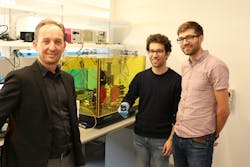Like other quantum materials, quantum topological materials are highly governed by quantum behaviors, especially in their electronic and photonic properties, which can be more robust than those of classical materials. While quantum topological materials may sound like something not very relevant to our everyday world, this is not so (or at least potentially), as they could be used to make future quantum computers less delicate.
Now, scientists from the Centre for Quantum Computation and Communication Technology (CQC2T) at RMIT University (Melbourne, Victoria), Consiglio Nazionale delle Ricerche and Politecnico di Milano, (both of Milano, Italy), and ETH Zurich (Zurich, Switzerland) have developed a topological photonic chip to process quantum information, promising a more robust option for scalable quantum computers.1
The research team, led by RMIT University's Alberto Peruzzo, has for the first time demonstrated that quantum information can be encoded, processed, and transferred at a distance with topological circuits on the chip. The breakthrough could lead to the development of new materials, new-generation computers, and deeper understanding of fundamental science.
The researchers used topological photonics, a rapidly growing field that aims to study the physics of topological phases of matter in a novel optical context, to fabricate a chip with a beamsplitter creating a high-precision photonic quantum gate.
"We anticipate that the new chip design will open the way to studying quantum effects in topological materials and to a new area of topologically robust quantum processing in integrated photonics technology," says Peruzzo. "Topological photonics have the advantage of not requiring strong magnetic fields, and feature intrinsically high-coherence, room-temperature operation and easy manipulation. These are essential requirements for the scaling up of quantum computers."
Replicating the hallmark nonclassical Hong-Ou-Mandel (HOM) experiment, which takes two photons and interferes them according to the laws of quantum mechanics, the team was able to use the photonic chip to demonstrate, for the first time, that topological states can undergo high-fidelity quantum interference (with 93.1 ±2.8% visibility).
Decreasing noise in quantum computers
HOM interference lies at the heart of optical quantum computation, which is very sensitive to errors. Topologically protected states could add robustness to quantum communication, decreasing noise and defects prevalent in quantum technology. This is particularly attractive for optical quantum information processing.
"Previous research had focussed on topological photonics using classical laser light, which behaves as a classical wave," " says Jean-Luc Tambasco, a PhD student at RMIT. "Here we use single photons, which behave according to quantum mechanics."
Demonstrating high-fidelity quantum interference is a precursor to transmitting accurate data using single photons for quantum communications, a vital component of a global quantum network.
The research is part of the Photonic Quantum Processor Program at CQC2T. The Centre of Excellence is developing parallel approaches using optical and silicon processors in the race to develop the first quantum computation system.
Source: https://www.eurekalert.org/pub_releases/2018-09/cfqc-npc090718.php
REFERENCE:
1. Jean-Luc Tambasco et al., Science Advances (2018); doi: 10.1126/sciadv.aat3187.
About the Author
John Wallace
Senior Technical Editor (1998-2022)
John Wallace was with Laser Focus World for nearly 25 years, retiring in late June 2022. He obtained a bachelor's degree in mechanical engineering and physics at Rutgers University and a master's in optical engineering at the University of Rochester. Before becoming an editor, John worked as an engineer at RCA, Exxon, Eastman Kodak, and GCA Corporation.

